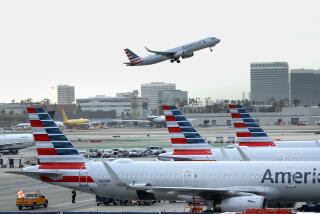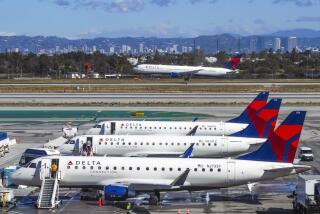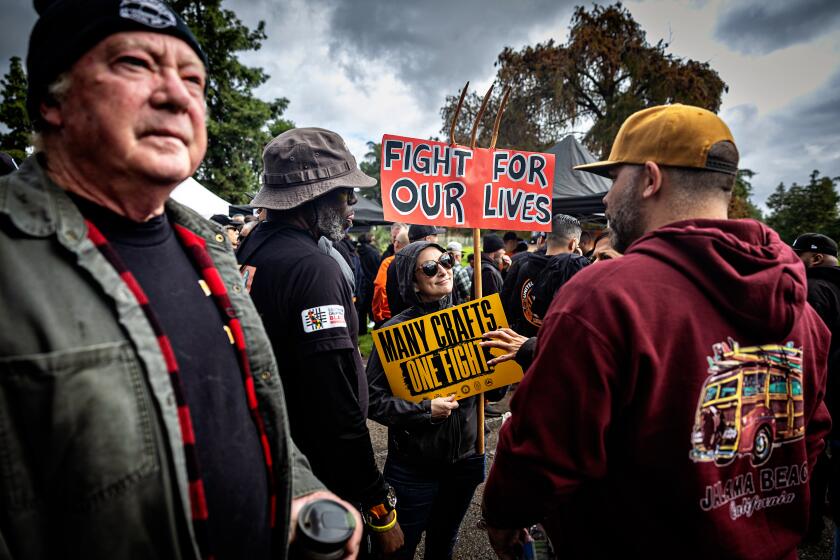U.S. and Europe may face off over reducing airline emissions
The Obama administration faces a possible confrontation with Europe over reducing carbon emissions when representatives of 191 countries gather this month in Montreal to develop global standards for aviation emissions.
Greenhouse gas emissions from commercial flights are growing at a steep rate, and nations participating in the International Civil Aviation Organization meeting said they hope that it leads to strong, enforceable standards. So far, the chances appear slim, according to observers.
Now, two months after President Obama articulated a reset of climate policy, environmentalists are calling for the administration to join a plan developed by the European Union that that would press airlines to cut emissions immediately. The European law levies a fee on greenhouse gas emissions for flights originating or ending in Europe.
It is strongly opposed by U.S. carriers, who have said it violates international law and penalizes longer routes that non-European airlines fly. Obama has sided with the airlines and in November signed a law that would shield U.S. carriers from the carbon fees.
If the Sept. 24 meeting in Montreal falters, it remains unclear whether the Obama administration is ready to embrace the stringent cuts to aviation emissions that Europe has devised.
“Aviation is one of the fastest-growing emissions sectors in the world,” said Deborah Lapidus, campaigns director at Catapult, a liberal consulting group. If the Obama administration hewed to its current policy, “it would be a complete contradiction stated to their commitment to battle climate change. They would be wasting another historic opportunity.”
The administration defended its opposition to the EU emissions scheme, saying that it did not contradict the White House’s commitment to fighting climate change.
“The U.S. has strongly supported reductions in greenhouse gas emissions,” a State Department official said on condition of anonymity. “The U.S. aviation industry, with federal help and encouragement, has achieved excellent results in reducing emissions.”
The official said U.S. airlines are consuming 10% less fuel than they were a decade ago despite a more than 15% increase in passengers and cargo.
The Obama administration and the U.S. carriers’ position on cutting emissions so far appears unchanged, focusing instead on the possibility of a global solution at the United Nations-backed International Civil Aviation Organization.
But U.S. environmentalists and EU officials said the EU developed its own plan to cut carbon dioxide emissions because of years of inaction by ICAO.
Discussions leading up to the September meeting indicate that it probably will not be able to produce a strong, enforceable emissions standard, critics said. The next ICAO global meeting is in 2016.
“It’s not our preference to do things unilaterally. The EU has always wanted a global solution,” said an EU official who spoke on condition of anonymity because of the sensitivity of the upcoming talks. “But climate change is not going away, and if anything, it is getting worse.”
Europe’s regulations and carbon-trading system helped rein in greenhouse gas emissions in most sectors over the last 15 years.
Aviation emissions are rising sharply. In Europe, they shot up 98% from 1990 to 2006, according to a 2011 European Commission report. By 2030, ICAO estimates that worldwide flight departures will increase to 59 million, compared with 31 million last year, driving prodigious growth in aviation emissions.
Under the European system, carriers pay an annual fee on every metric ton of greenhouse gas emitted in flights to and from Europe. Tied to the European Union’s carbon-trading markets, the fee fluctuates but has been around two euros ($2.64) per metric ton in recent days, the EU official said.
The EU scheme would add from $4 to $18 per passenger ticket, according to various studies.
If a carrier wants to reduce its fees, it has to find ways to cut emissions, such as buying newer, more fuel-efficient aircraft; flying bigger planes, which use less fuel per passenger; or using more biofuels and training pilots to fly more efficiently.
Airlines flying within Europe began paying fees in 2012, with no effect so far on the number of flights or passengers. But foreign airlines have balked, led by U.S. carriers such as United.
The EU scheme “is bad news for customers, airlines and, ironically, the environment,” said Nancy Young, vice president for environmental affairs at Airlines for America, the U.S. carriers’ trade group.
“It is quite simply an exorbitant, extraterritorial cash grab for financially troubled European countries, which under the law can use the money however they see fit,” she said.
An Aug. 27 report issued by Britain’s Manchester Metropolitan University’s Centre for Air Transport and Environment said the EU’s fee system and a global emissions trading program similar to it would reduce aviation emissions far more substantially than other measures the airline industry and governments have touted, like biofuels and technological improvements.
Last year, U.S. carriers lost a legal challenge to the EU emissions scheme in a European court. But so far, they have had the backing of the White House and Congress.
The administration persuaded the EU to delay implementation of the carbon fee scheme to let ICAO devise its own plan this year. Congress also passed a measure that would give the secretary of Transportation authority to protect U.S. air carriers from the EU emissions fee, which Obama signed in November 2012.
If ICAO fails to issue a binding worldwide standard, the EU emissions legislation will go into effect for international carriers, with payments for 2013 emissions due in April 2014.
Those who fail to pay will face penalties of 100 euros ($132) per metric ton of greenhouse gases. If U.S. carriers ignore the penalties, the EU might take retaliatory steps, sparking a “trade war,” as Secretary of State John Kerry spoke of in July 2012, when he was a senator.
“We do have a president who understands the need to fight climate change and yet is not willing to put the full resources of the administration to it,” said Michael Brune, executive director of the Sierra Club.
“For every three steps forward, there are one and a half steps back,” he said. “It’s a constant ebb and flow.”







